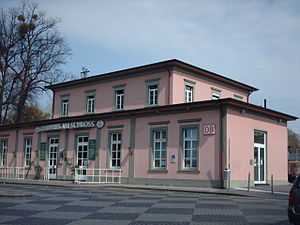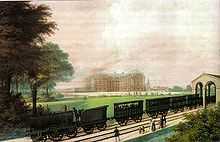Brühl station
Brühl station | |
|---|---|
 Entrance building | |
| Location |
Brühl, North Rhine-Westphalia, North Rhine-Westphalia Germany |
| Coordinates | 50°49′45″N 6°54′44″E / 50.82917°N 6.91222°ECoordinates: 50°49′45″N 6°54′44″E / 50.82917°N 6.91222°E |
| Line(s) | West Rhine Railway |
| Platforms | 3 |
| Construction | |
| Architect | Johann-Peter Weyer |
| Other information | |
| Station code | n/a |
| DS100 code | KBR |
| Category | 4 |
| History | |
| Opened | 15 February 1844 |
Brühl station is a train station in the city of Brühl in the German state of North Rhine-Westphalia. It consists of a passenger station and a freight yard about a kilometre to the north. Both parts of the station are on the Left Rhine line (German: Linke Rheinstrecke); the freight yard also has a connection via Brühl-Vochem to the Cologne port and freight railway network (Häfen und Güterverkehr Köln AG, HGK).
History

Brühl station was opened on 15 February 1844 by the Bonn-Cologne Railway Company (Bonn-Cölner Eisenbahn-Gesellschaft, BCE) on the occasion of the visit of Queen Victoria and was from the beginning the most important stop between Cologne and Bonn. The station building was built on the first single-track line in sight of the Augustusburg Palace to a design by Johann Peter Weyer. Since large parts of the line run towards the grand estates, this enabled the royal family to make its influence felt.
In 1869 a second track was built, and the station building relocated to a central platform. At this time the freight yard was located just to the north on the eastern side of the line.
In 1910 to 1913 there was an extensive reorganisation of the railways in Brühl. In particular, it included the construction of a four metre high embankment to enable the removal of level crossings with other transport routes. The station was on both sides of the line with a passing track and two island platforms between the main tracks and the siding, which are reached by an underpass. Since there was no longer enough room near the station for the freight yard, it was moved further north on the western side of the track. Between the two parts of the station, a bridge carried the lateral line of the Cologne port and freight railway over the Left Rhine line; this connected via a circular route to the Köln-Bonner Eisenbahnen (KBE, "Cologne-Bonn Railway") line (now line 18 of the Cologne Stadtbahn) and from Vochem a track branched off to the new freight yard.
In a railway accident at Brühl on 6 February 2000, nine people lost their lives and 149 more were injured when a train running from the north on the opposite track at excessive speed ran on to the eastern siding and derailed. While the front of the train plunged down the embankment and slammed into an apartment building, the rear part of it was pulled across the platform and was crushed against a pillar supporting the platform roof. Contributing factors in the accident included the separation of the freight and passenger sections of the station along with the lack of intermediate as well as exit signals and the operations of trains on the main track in the opposite direction to normal operations. During the clean up after the accident, the siding on the eastern side was completely removed, the platform was shortened and a noise barrier was built on the eastern side.

As part of the North Rhine-Westphalia modernisation campaign of 2006, the access tunnel to the platform was widened and the stairs were provided with wheel chair lifts.
Transport links
The passenger station is served by all regional passenger services on the Left Rhine line, each at hourly intervals:[1]
- Rhein-Express (RE 5)
- Mittelrheinbahn (MRB 26)
- Rhein-Wupper-Bahn (RB 48)
| Preceding station | Deutsche Bahn | Following station | ||
|---|---|---|---|---|
toward Koblenz Hbf | RE 5 Rhein-Express | toward Emmerich |
||
toward Bonn-Mehlem | RB 48 Rhein-Wupper-Bahn | toward Wuppertal Hbf |
||
| Preceding station | trans regio | Following station | ||
toward Koblenz Hbf | MRB 26 MittelRheinBahn | toward Köln Messe/Deutz |
The only bus connection to station is line 990, running every half hour on weekdays and every hour on weekends. In the summer months there is also a private shuttle service to Phantasialand.
Notes
- ↑ "Brühl station". NRW Rail Archive (in German). André Joost. Retrieved 30 October 2011.
References
- Horst Semmler (1994). 150 Jahre Eisenbahn Bonn–Köln (in German). Nordhorn: Verlag Kenning. ISBN 3-927587-23-0.
External links
- "Track plan of Brühl station" (PDF, 179,45KB) (in German). Retrieved 1 May 2011.
- station diagram map by Verkehrsverbund Rhein-Sieg (German)